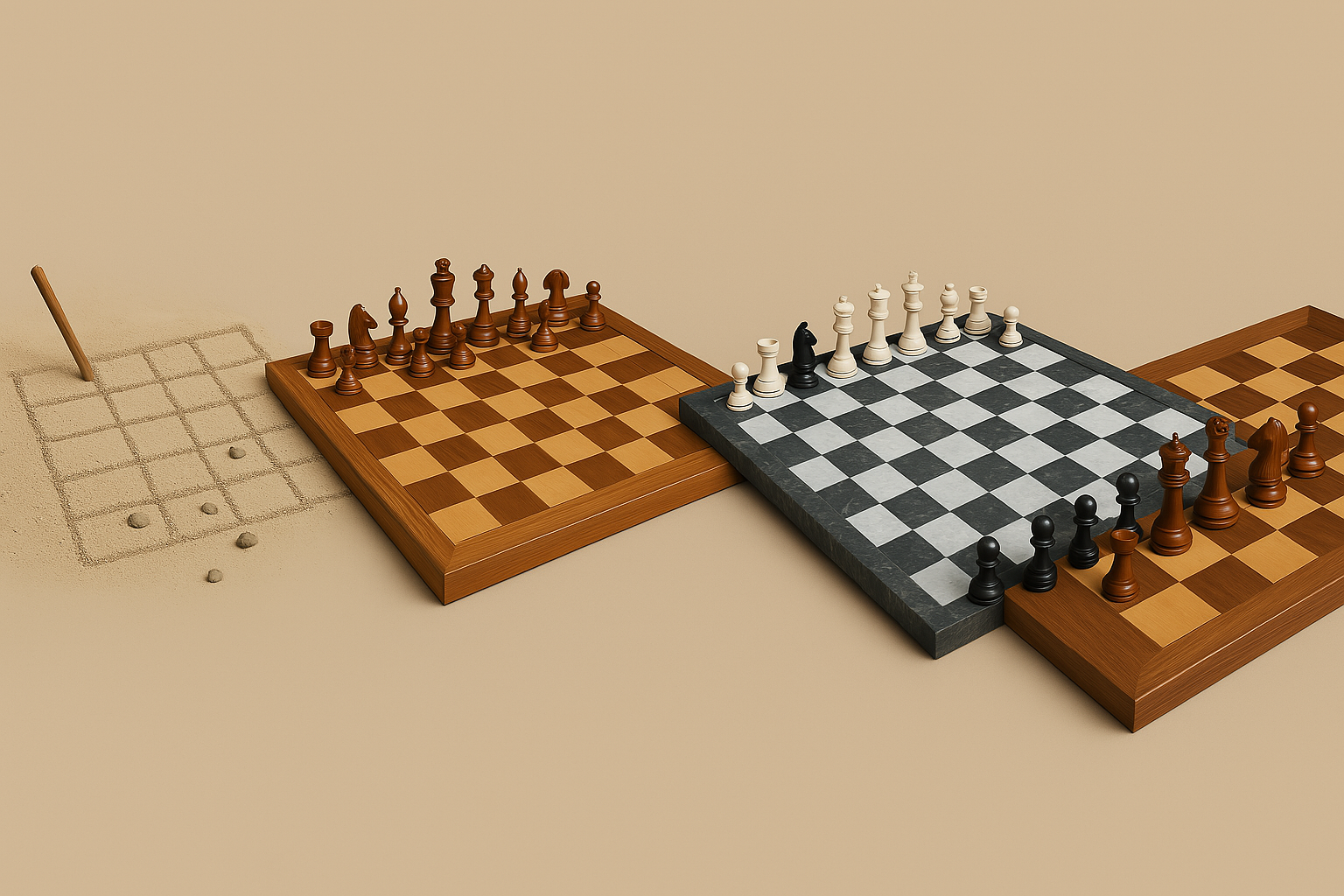Evolution of chess boards Summary: Take readers on a journey through the evolution of chess boards—from simple sand drawings to luxurious wooden and marble designs.
Sample Hook:
“Did you know the first chess boards weren’t even boards at all? Centuries ago, players drew grids in the dirt. Today, chess boards are heirlooms—each with its own story. Let’s explore how they’ve changed over time!”
Introduction: A Game That Shaped Civilizations
Evolution of chess boards
Chess transcends a mere board game; over 1,500 years, its evolving playing surfaces mirror the technological, artistic, and cultural shifts of civilizations. From the sands of 6th-century India, where Chaturanga players etched grids in dirt, to Persian ivory and ebony boards symbolizing luxury, medieval European oak and marble status pieces, Renaissance marquetry masterpieces, and the 19th-century Staunton standard, each board tells a story. Designers blend sustainability, technology, and craftsmanship in artisan sets. The chess board’s journey from improvised battlefield sketch to heirloom artwork encapsulates human creativity and strategic thought, inviting players to connect with history in every move.
From crude battlefield sketches to hand-carved walnut heirlooms, the chessboard’s journey mirrors human ingenuity. Let’s unravel how this timeless battlefield evolved—and why today’s artisan boards are works of art.
1. The Humble Beginnings: Chess Boards in Ancient Times
Evolution of chess boards
6th Century India: Chaturanga on Dirt
- The earliest chess variant, Chaturanga, was played on cloth or dirt grids in India.
- No physical “board”—lines were drawn in sand or etched onto stone.
- Symbolism: The 8×8 grid mirrored Indian military strategy.
Persian & Islamic Influence: The Birth of Luxury
- By the 10th century, Persian craftsmen created wooden boards with intricate carvings.
- First recorded luxury sets: Made for caliphs, featuring ivory and ebony.
- Key innovation: Contrasting light/dark squares for visibility.
“Chess migrated from war simulations to royal courts—and so did its boards.”
2. Medieval Europe: Chess Boards as Status Symbols
Evolution of chess boards
The Gothic Era (12th–15th Century)
- Material shift: European nobility demanded oak, marble, and metal boards.
- Religious influence: Some sets depicted Biblical scenes (e.g., ivory Crusader sets).
- Size mattered: Larger boards symbolized wealth (some spanned 3 feet wide!).
The Lewis Chessmen (12th Century)
- Discovered in Scotland, these walrus-ivory pieces hinted at stone and wood boards.
- Design evolution: Abstract carvings → realistic human/animal figures.
3. The Renaissance: Chess Boards Meet Artistry
Evolution of chess boards
16th–18th Century: A Golden Age for Craftsmanship
- Italian & German artisans pioneered:
- Inlaid wood boards (marquetry techniques).
- Folding travel sets for merchants and diplomats.
- Symbol of intellect: Chessboards appeared in Da Vinci’s sketches and royal portraits.
The Staunton Revolution (1849)
- The modern chessboard design emerged alongside the Staunton pieces.
- Standardization: 2.25″ squares, ebony vs. boxwood contrast.
- Mass production began—but handmade boards remained elite.
4. Modern Chess Boards: Where Art Meets Function
Evolution of chess boards
20th Century: Materials Go Wild
- Bauhaus movement: Minimalist glass and steel boards.
- Cold War era: USSR-produced redwood sets (propaganda tools).
- 1980s–90s: Nostalgia for hand-carved walnut and mahogany.
21st Century: The Rise of Artisan Boards
Today’s luxury chess boards blend tradition with innovation:
- Sustainable woods (reclaimed teak, FSC-certified maple).
- Tech-infused designs (LED boards, magnetic travel sets).
- Custom heirlooms: Engraved family crests, gemstone accents.
“From sand to sapphires—chess boards now rival museum pieces.”
5. Why the Evolution Matters to Modern Players
- Cultural artifacts: Your board carries centuries of history.
- Investment potential: Antique boards sell for thousands at auction.
- Personal connection: A handmade board ties you to the game’s legacy.
Conclusion: The Chessboard’s Timeless Journey
The evolution of chess boards mirrors human progress—from ancient strategy to modern artistry. Whether you prefer a vintage Staunton set or a sleek marble masterpiece, your board is part of this 1,500-year story.

